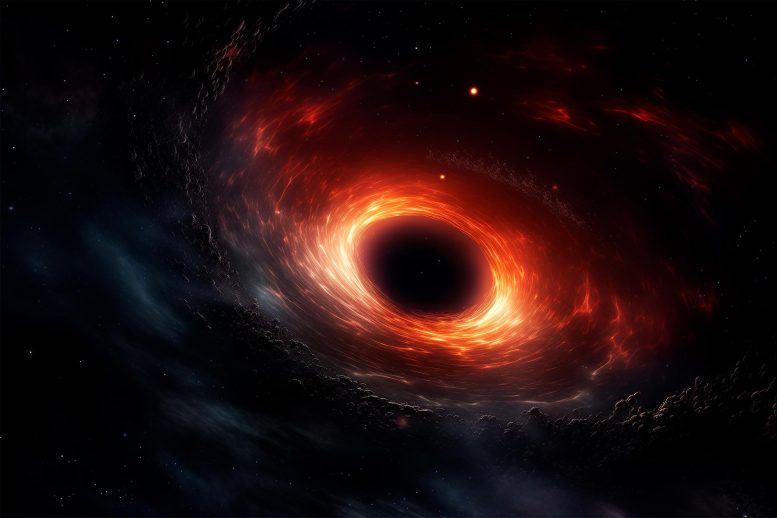
Researchers, using the James Webb Space Telescope, have discovered the oldest known black hole, challenging existing theories about black hole formation. This discovery, considered a significant advancement in astronomy, could lead to the identification of even older black holes and deepen understanding of their origins. Credit: SciTechDaily.com
Astronomers have discovered the universe’s oldest black hole with the JWST, challenging current theories of black hole growth and potentially impacting the development of its host galaxy, GN-z11.
Researchers have discovered the oldest black hole ever observed, dating from the dawn of the universe, and found that it is ‘eating’ its host galaxy to death.
The international team, led by the University of Cambridge, used the James Webb Space Telescope (JWST) to detect the black hole, which dates from 400 million years after the Big Bang, more than 13 billion years ago. The results, which lead author Professor Roberto Maiolino says are “a giant leap forward,” are reported in the journal Nature.
“It’s a new era: the giant leap in sensitivity, especially in the infrared, is like upgrading from Galileo’s telescope to a modern telescope overnight.” — Roberto Maiolino
The international team, led by the University of Cambridge, used the James Webb Space Telescope (JWST) to detect the black hole, which dates from 400 million years after the Big Bang, more than 13 billion years ago. The results, which lead author Professor Roberto Maiolino says are “a giant leap forward,” are reported today (January 17) in the journal Nature.
Challenging Existing Theories
That this surprisingly massive black hole – a few million times the mass of our Sun – even exists so early in the universe challenges our assumptions about how black holes form and grow. Astronomers believe that the supermassive black holes found at the center of galaxies like the Milky Way grew to their current size over billions of years. But the size of this newly-discovered black hole suggests that they might form in other ways: they might be ‘born big’ or they can eat matter at a rate that’s five times higher than had been thought possible.
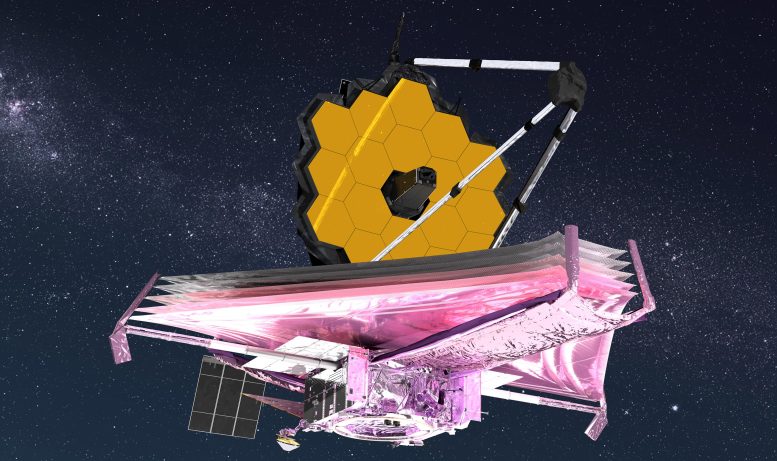
In this illustration, the multilayered sunshield on NASA’s James Webb Space Telescope stretches out beneath the observatory’s honeycomb mirror. Credit: NASA GSFC/CIL/Adriana Manrique Gutierrez
Formation of Supermassive Black Holes
According to standard models, supermassive black holes form from the remnants of dead stars, which collapse and may form a black hole about a hundred times the mass of the Sun. If it grew in an expected way, this newly-detected black hole would take about a billion years to grow to its observed size. However, the universe was not yet a billion years old when this black hole was detected.
“It’s very early in the universe to see a black hole this massive, so we’ve got to consider other ways they might form,” said Maiolino, from Cambridge’s Cavendish Laboratory and Kavli Institute of Cosmology. “Very early galaxies were extremely gas-rich, so they would have been like a buffet for black holes.”
Like all black holes, this young black hole is devouring material from its host galaxy to fuel its growth. Yet, this ancient black hole is found to gobble matter much more vigorously than its siblings at later epochs.
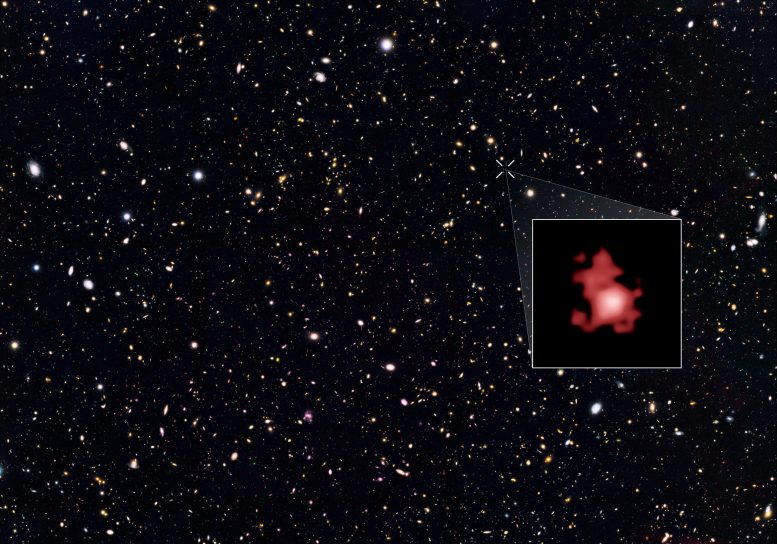
This image shows the position of the most distant galaxy discovered so far within a deep sky Hubble Space Telescope survey called GOODS North (Great Observatories Origins Deep Survey North). The survey field contains tens of thousands of galaxies stretching far back into time. The remote galaxy GN-z11, shown in the inset, existed only 400 million years after the Big Bang, when the Universe was only 3 percent of its current age. It belongs to the first generation of galaxies in the Universe and its discovery provides new insights into the very early Universe. This is the first time that the distance of an object so far away has been measured from its spectrum, which makes the measurement extremely reliable. GN-z11 is actually ablaze with bright, young, blue stars but these look red in this image because its light was stretched to longer, redder, wavelengths by the expansion of the Universe. Credit: NASA, ESA, and P. Oesch (Yale University)
Black Hole’s Impact on Its Galaxy
The young host galaxy, called GN-z11, glows from such an energetic black hole at its center. Black holes cannot be directly observed, but instead they are detected by the tell-tale glow of a swirling accretion disc, which forms near the edges of a black hole. The gas in the accretion disc becomes extremely hot and starts to glow and radiate energy in the ultraviolet range. This strong glow is how astronomers are able to detect black holes.
GN-z11 is a compact galaxy, about one hundred times smaller than the Milky Way, but the black hole is likely harming its development. When black holes consume too much gas, it pushes the gas away like an ultra-fast wind. This ‘wind’ could stop the process of star formation, slowly killing the galaxy, but it will also kill the black hole itself, as it would also cut off the black hole’s source of ‘food’.
New Era in Astronomy
Maiolino says that the gigantic leap forward provided by JWST makes this the most exciting time in his career. “It’s a new era: the giant leap in sensitivity, especially in the infrared, is like upgrading from Galileo’s telescope to a modern telescope overnight,” he said. “Before Webb came online, I thought maybe the universe isn’t so interesting when you go beyond what we could see with the Hubble Space Telescope. But that hasn’t been the case at all: the universe has been quite generous in what it’s showing us, and this is just the beginning.”
Maiolino says that the sensitivity of JWST means that even older black holes may be found in the coming months and years. Maiolino and his team are hoping to use future observations from JWST to try to find smaller ‘seeds’ of black holes, which may help them untangle the different ways that black holes might form: whether they start out large or they grow fast.
Reference: “A small and vigorous black hole in the early Universe” by Roberto Maiolino, Jan Scholtz, Joris Witstok, Stefano Carniani, Francesco D’Eugenio, Anna de Graaff, Hannah Übler, Sandro Tacchella, Emma Curtis-Lake, Santiago Arribas, Andrew Bunker, Stéphane Charlot, Jacopo Chevallard, Mirko Curti, Tobias J. Looser, Michael V. Maseda, Tim Rawle, Bruno Rodríguez Del Pino, Chris J. Willott, Eiichi Egami, Daniel Eisenstein, Kevin Hainline, Brant Robertson, Christina C. Williams, Christopher N. A. Willmer, William M. Baker, Kristan Boyett, Christa DeCoursey, Andrew C. Fabian, Jakob M. Helton, Zhiyuan Ji, Gareth C. Jones, Nimisha Kumari, Nicolas Laporte, Erica Nelson, Michele Perna, Lester Sandles, Irene Shivaei and Fengwu Sun, 17 January 2023, Nature.
DOI: 10.1038/s41586-024-07052-5
The research was supported in part by the European Research Council, the Royal Society, and the Science and Technology Facilities Council (STFC), part of UK Research and Innovation (UKRI).

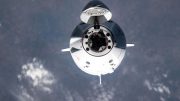



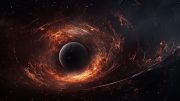



Either the universe is older than we currently believe, and this black hole is also much older so it had more time to grow, or possibly something else contributed towards the formation of these early formed black holes, like dark matter, which could explain the accelerated rate of consumption.
Knowing and demonstrating (“1Gravity:” https://odysee.com/@charlesgshaver:d/1Gravity:8) that rotation intensifies the gravity of any object, I postulate the reason for such a large black hole being formed so early was the higher angular velocity of the entire galaxy, from it’s more violent origin. No imaginary dark matter required.
They’re sure it’s a “black hole” because it can’t be a galactic “noodle” or “banana.”
Speaking of things that remind me that gravity dilates photons as opposed to Einstein’s incredibly over-sensationalized gravitational time dilation “theory” … the money-mad media mob will deny reality to say whatever they think will eventually render Einstein’s failure to understand “spooky” spin at a distance invisible. They can’t so easily change his name to “Kerr” or “Lense,” however. Funny thing is Kerr and Lense-Thirring don’t go far enough, but billionaire globalist media is too embarrassed to be cheering on any quantizing of gravitational action, particularly any quantizing of massless gravitational spin.
Let’s suppose this “noodle banana” effect has everything to do with gravitational photon dilation, “squashed” polarizations, and galaxies sitting quite naturally, far, far away, and largely equatorially aligned, on “sheets” of image-cohering “dark matter” gravity effect.